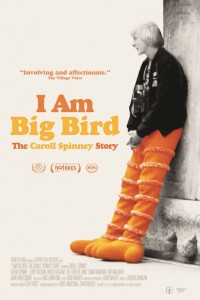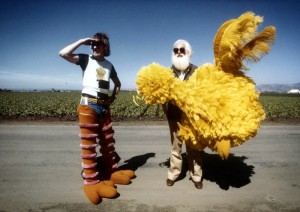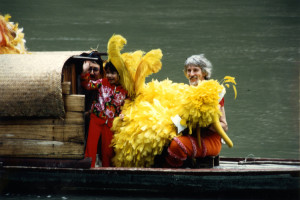 Documentarians Dave LaMattina and Chad N. Walker spent five years unfurling the life of the man behind one of the most famous figures of modern culture: Caroll Spinney, the puppeteer who has played Big Bird on Sesame Street since 1969 (portions of this interview originally appeared at austinchronicle.com).
Documentarians Dave LaMattina and Chad N. Walker spent five years unfurling the life of the man behind one of the most famous figures of modern culture: Caroll Spinney, the puppeteer who has played Big Bird on Sesame Street since 1969 (portions of this interview originally appeared at austinchronicle.com).
Richard Whittaker: Everyone knows Big Bird, but how did you even become aware of Caroll?
Dave LaMattina: In 2005, I was interning at Sesame Workshop, because I wanted to go into family entertainment, and it was the pinnacle of place you could be for that. Great internship, and then a year or two later I was telling a friend about the various internships I’d had, and I said something about Sesame Street, and she said, oh, I’m actually family friends with Caroll Spinney. I didn’t know who that was, and thought Carroll was a woman, and she proceeded to tell me that he’s a man, and he’s been Big Bird and Oscar the Grouch since 1969.
So Chad were emailing, as we are want to do, and we were kicking around some doc ideas, and that came up and we couldn’t really let go of of it. We reached out to Sesame, thinking this would be a lot of red tape. and I think within a week we had a meeting set up with Carroll.
Chad N. Walker: It was probably the best meeting you could possibly have. [Caroll and wife Debra] were two of the sweetest people you could imagine. You could tell immediately that they were in love like none other. Halfway through the meeting, Deb says, I’m not a professional or anything, but I’ve pretty much video taped everything we’ve ever done. Would you guys like to use that? Yes. Yes, we would.
RW: So how much material did she have? Because, between your original material, the animation, the Children’s Television Workshop archives and the Henson Company material, you must have been winnowing through a lot of footage.
CNW: It was probably close to 400 hours of stuff that Caroll and Deb shot, not even talking about all the old episodes of Sesame Street we went through and that kind of stuff. It was an amazing amount, box after box. The first box Deb dropped off had behind the scenes that no-one had ever seen of A Muppet Family Christmas, so it was really amazing. But there were definitely some dark signs, where as soon as VHS hit, they would just stick the camera in the windshield and be driving through New Zealand. It would be four hours of them just driving, and you’re holding your eyes open, just trying to get through it because you knew, even if in that case, it would cut and you have this amazing, adorable moment.
Like that New Zealand example, it was literally extended play VHS, and five hours into that tape it randomly cuts and they’re having a picnic. It’s the moment in the film when Caroll jumps up and runs down the hill and rolls. That’s why we sat here for five hours, because that moment is really magical and amazing.

RW: I have to ask, because it’s something that has been driving me mad. You talk a lot about the puppeteering techniques and how Carroll performs, but there’s one thing you never mention in the film. Carroll is both Big Bird and Oscar, so how did they shoot the scenes when Big Bird and Oscar are talking?
DLaM: It’s a fascinating dance. What they do is that Caroll will pre-record the dialog, typically for whichever puppet has the least amount of dialog, and then another puppeteer will jump in either the Oscar or the Big Bird puppet that Caroll pre-recorded, and they will then essentially catch Caroll’s voice. It’s like a coordinated dance, and it’s totally insane.
If you’ve seen the film, there’s a moment when Jerry Nelson, who’s no longer with us, he was doing the Count’s voice, but he was no longer doing the puppet. so Matt Vogel, who does a ton of characters, not only is he Caroll’s understudy for Big Bird, and he’s all these characters on The Muppet Show, and he directs episodes of Sesame Street, Matt Vogel is actually catching Jerry Nelson’s voice live. It’s an incredible skill that these men and women have.
AC: Puppeteering is such an individual skill, but on something like Sesame Street, it’s so collaborative. so how hard was it for you as documentarians to not wander off-topic and make this a history of the entire show?
DLaM: There are a lot of people who have done a lot of Sesame Street retrospectives, and there are a lot of fans that we relied on for facts and background stuff that we relied on for great details, so everything we deal with in the film, we deal with as Caroll experienced it. That was our lens, whether it was Jim [Henson]’s death which obviously countless other news stories and artistic pieces have covered in their own way, how did that affect Caroll personally. That was our filter for every scene.
CNW: It gave us a unique perspective through one person’s eyes. How they felt, what they did.
RW: There’s a long history of kids entertainers that don’t like kids, or aren’t particularly nice people, but Caroll seems to be as sweet as one could hope. What was it like getting to know him and Deb?
DLaM: The funny thing is that was very easy to get to know Caroll and Deb because they are that open. From the first conversation we had with them, we had that connection with them. I’d like to think it’s something special about Chad and I. However, I think it’s something special about Caroll and Deb that made them open to meeting new people. What we would find is that they would be very open with us off-camera, and tell us all these things off-camera about things that had impacted them. But then we’d go to talk about that on camera, and they’d be a little reluctant. Or Caroll, after 40 years of being on television, has told the same story of meeting Jim Henson a million times, because he knows that’s what people want to hear. So somehow we would ask him about the Challenger [Spinney was supposed to go on the doomed Space Shuttle], and we’d wind up talking about Jim Henson and how he met him. Eventually, the level of trust got to the point with us that we could go, you know guys, what you’re telling us off-camera gives us a true understanding of who you are as people – and we always put them together, because you can’t separate them – and it’s really what made Big Bird and Oscar the characters they are, and that’s what we need to capture in this film, because otherwise it’s going to be pretty boring. We’re going to ask you some things that aren’t necessarily the most comfortable things to talk about, but we’re going to need you to talk about that stuff, like you do off-camera, so people get to understand you like we have. They trusted us, and they were very happy with the result.
CNW: It took five years to make that movie, so we were with them a lot. I think that, not only did we have to do that because we had so much footage to go through, but it really was key to building the relationship that we have with them. They really got to know us. We had kids during the production of this. We just all kind of did become more like family. They really did trust us, and I really do think it came down to the amount of time we were able to spend making the movie.

RW: It’s always a big question for me with documentarians who are focusing on one person, rather than an event. How did you know when you had enough to tell the story, that you’d reached a natural full stop?
DLaM: I think for us it was when we had an understanding of what we were trying to tell. At first, we jumped into this going, oh, we’re going to tell the story of this guy’s last years, because he’s 78. He’s definitely going to retire. Even if it takes two years, we’ll make this. The very first day, he’s like, no, guys, I’m not retiring. I’m going to do this for 50 years and beyond if I can.
So that went out the window.
Then it was finding out what the film is. Obviously you have these moments of Caroll’s life that help shape the character, but then there’s one interview with Laurent Linn, who’s a former Muppet wrangler and one of Caroll and Deb’s best friends. He closes the film by saying the secret to Big Bird is love. That was true, and so we took that theme and applied it through his life. Then when we have the reunion of Caroll and Deb with this little girl from Big Bird in China, who really they only knew for a month or six weeks but they’ve always been searching for. That felt like a good way to end the movie.
But we didn’t have a timeline of shooting, necessarily. It was more, here’s all these people we want to talk to, to capture these themes and tell Caroll’s story.
CNW: That can only be dangerous, right? If it’s not like a sports doc, which has an ending built in, it can go on for a lot longer than you anticipated. When that meeting with Lisa that closes the movie came up, we thought, what better relationship epitomizes that theme of love throughout the movie than their relationship with this girl? That really felt like a natural ending.
RW: That scene is one of those perfect emotional moments that documentarians dream about. How did it happen?
CNW: Oddly enough, Dave’s favorite Big Bird movie was Big Bird in China, so it started out as a conversation, them talking off-camera about that. Then, all of a sudden, he starts telling us all these crazy stories, and about Lisa.
DLaM: They reconnected. It started with one of these Muppet fan sites, somebody had written a posting about, oh, does anyone know what happened here? Then strangely enough Lisa responded and updated, and that lead to them getting in contact. Once that contact had been made, they were filming a retrospective, which was 25 years, and so when she was coming we were like, wow, we should probably capture that.
RW: One fascinating part of puppetry is that, the instant the puppet goes on, people stop interacting with the human. They become a blank space, and everything is about the puppet. Last year, there was a photo op at SXSW with Cookie Monster, and (puppeteer) David Rudman was there, and everyone was just talking to Cookie Monster. When you were dealing with Oscar or Big Bird, was it hard to remember that you’re dealing with the man inside?
DLaM: It’s impossible to ignore the puppet. I can’t tell you how many times we were with Oscar or Big Bird, and despite knowing what goes in to making the magic, it’s still magical. It still feels like there’s a new being in the room. I think the puppeteers love that, because it’s such a testament to how magical their work is. But we also saw the flipside of that on the press tour with Caroll. We’d be out at a festival after a screening, and he’d had Oscar in his little duffle bag that he’d bring with him. People would see Caroll the person, and they would just cry. I think, for certain Muppet performers, that adulation exists. I think you see that with Frank Oz, David probably as well, because he’s done so much.
We spoke with Big Bird at a festival in New York, and it was the first time we had ever had him talking with us, because Big Bird’s hard to transport, and they can’t take him places. So when they’re not rolling cameras, Big Bird is put away. So this is the first time we’ve been hanging out with Big Bird, and this is is probably five years into our relationship with Caroll and Big Bird and Oscar. We were supposed to deliver lines, and I totally botched my lines, because I was in awe. Especially Big Bird, because he’s so big. he’s such a massive presence.
But Oscar’s really funny. Caroll, on his own, in the same Q&A, will go from being, not meek, but sweet, unassuming, really friendly Caroll, to really sharp, quick-witted, funny Oscar. It’s just when he puts that puppet on. It’s like a transformation he makes in his life, that doesn’t really exist unless Oscar’s there.
RW: Puppeteering is physically tough, but Big Bird, I really can’t imagine how Caroll does that, having his body in this strange position, with one arm above his head all the time. Where there any conversations about how him getting older was affecting him?
DLaM: It’s two fold. One is that, at age 80, he’s doing something that I couldn’t do right now at 35. I could with training, but if I were to step into that bird suit directly after Caroll, and try to mimic what he does, I couldn’t do. It’s that hard. But yeah, physically, he’s lost some of what he had, and I think he knows that, and I think that’s one of fascinating things about us for this is watching someone age out of something they love. I don’t think sad is the right word, because I don’t think Caroll’s sad about it. He loves the character, he’d never do anything to hurt that character, and he’ll step away and just do the voice when the time is right.